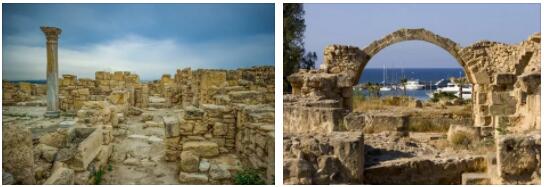Sights of Cyprus

The very name of the island of Cyprus is shrouded in secrets and legends. Today, history and hedonism are intricately intertwined here. Everywhere the typical Mediterranean landscape is blessed with the unfading beauty of antiquity: crusader fortresses surrounded by tall cypresses, Greco-Roman amphitheaters carved into the cliffs, Byzantine monasteries perched on mountain peaks. In cosmopolitan cities, elements of antiquity and modernity are harmoniously intertwined. The capital of Cyprus, Nicosia, is full of attractions:
“Old Nicosia”, i.e. the central part of the city, has a radial layout and is surrounded by a ring of impressive stone bastions and massive gates of the Venetian wall (1567-1570).
Famagusta Gate -one of the architectural masterpieces of the protective ring of old Nicosia. Exhibitions and musical evenings are regularly held in their interiors (the excellent restoration of the gates was awarded the international prize “Europa Nostra”).
According to Getzipcodes.org, the Archbishop ‘s Palace is one of the main attractions of the capital. Here is the residence of the highest clergyman of Cyprus, and given the importance that the Orthodox Church had and has in the life of Cypriots, this place can rightly be considered the heart of the country. In front of the palace there is a monument to Archbishop Makarios III, the first president of independent Cyprus.
Byzantine Museum and Art Gallery located in the very residence of the archbishop, they are famous for one of the world’s best collections of Byzantine icons of the 8th-9th centuries and a rich library.
The municipal park is the best place for walking and relaxing.
The Cyprus Museum is the most interesting museum in Nicosia, the largest archaeological museum on the island. Its expositions and individual exhibition galleries occupy 14 halls.
Curium is an ancient city-state, one of the most significant archaeological sites in Cyprus. It is located on a hill with a majestic view of the coast, washed by the sparkling azure sea.
Limassol. Numerous architectural monuments of the city and its environs can compete with any historical region of the Mediterranean. The fortress of Limassol, built at the beginning of the XIV century on the ruins of a Byzantine castle. The English king Richard the Lionheart and Berengaria of Navarre were married in her chapel.
“Aphrodite’s Font” – a grotto where, according to legend, the goddess of love once basked. Amathus -one of the oldest cities in Cyprus, which arose a thousand years before our era and flourished for sixteen centuries. In the 7th century AD the city was destroyed by the Arabs, and completed the destruction of Richard the Lionheart, who landed in these places in 1191. Modern archaeologists have unearthed an early Christian basilica, a sanctuary of Aphrodite, ruins of bathhouses and aqueduct systems. All this is rather poorly preserved, but even in this form it makes an impression.
Kikko Monastery, the most famous and richest monastery on the island. It was specially built to store one of the three holy icons, which, according to legend, the Apostle Luke painted with his own hand from the Mother of God. It can still be seen today in the monastery church -it is covered with a precious salary, and its upper part is draped with matter, which is removed only when the icon is taken out of the church to attract rain. Another miraculous relic of the monastery is a belt, which is believed to help women recover from infertility. In the late 80s of the XX century the monastery was restored, murals and beautiful mosaics appeared, and the largest of the monastery bells (1280 kg) was cast in Russia.
Larnaca is located on the site where once was built in the tenth century. BC. and the city of Kition, repeatedly mentioned in the Bible, founded by the grandson of Noah.
The most interesting biblical moment in the history of this region is the life and miraculous resurrection from the dead by Jesus of the most famous local resident- Saint Lazarus. Lazar after the resurrection moved to Cyprus and lived here for 30 years, becoming the first bishop of the current Larnaca. Here, in Kition, he was buried.
In his memory, the church of St. Lazarus was built in the center of the city. On the marble sarcophagus of the saint is engraved the inscription: “Lazarus, friend of Christ.” St. Lazarus is still considered the patron saint of Larnaca, and a week before Orthodox Easter, the townspeople celebrate the Resurrection of Lazarus, carrying an icon dedicated to him through the streets of the city, which is kept in the church for the rest of the time.
The Church of Panagia Angeloktistos, according to legend, was built by angels. The name of the church is translated as “built by angels”.
salt lake located near Larnaca Airport. According to legend, St. Lazarus turned a man who refused to give him a bunch of grapes into a salt lake. In winter, flocks of pink flamingos fly to the lake.
Camel Park, the first and only of its kind . In 1998, only 25 dromedaries were brought to these parts, and since then they have multiplied and managed to turn into local favorites of the public, remaining, nevertheless, quite working animals, which are studied and intensively used for simple work.
Shipwreck Museum in Kyrenia. Here are exhibits from the oldest ship found by underwater archaeologists off the coast of Cyprus.
Paphos is extremely interesting, which is famous for its relic pine forest, walks in which, according to Cypriot beliefs, prolong life and help with various diseases, beautiful and well-preserved mosaics, on the ruins of the villas of Dionysus, Theseus and Aion, included in the UNESCO World Cultural Heritage Register by the Odeon Theater, built by the Romans in the 2nd century AD, one of the most impressive buildings of antiquity, the baths of Aphrodite, the column of St.